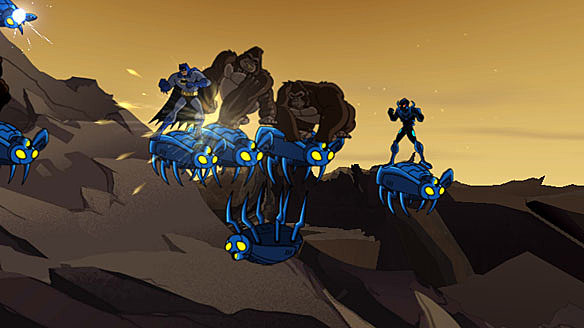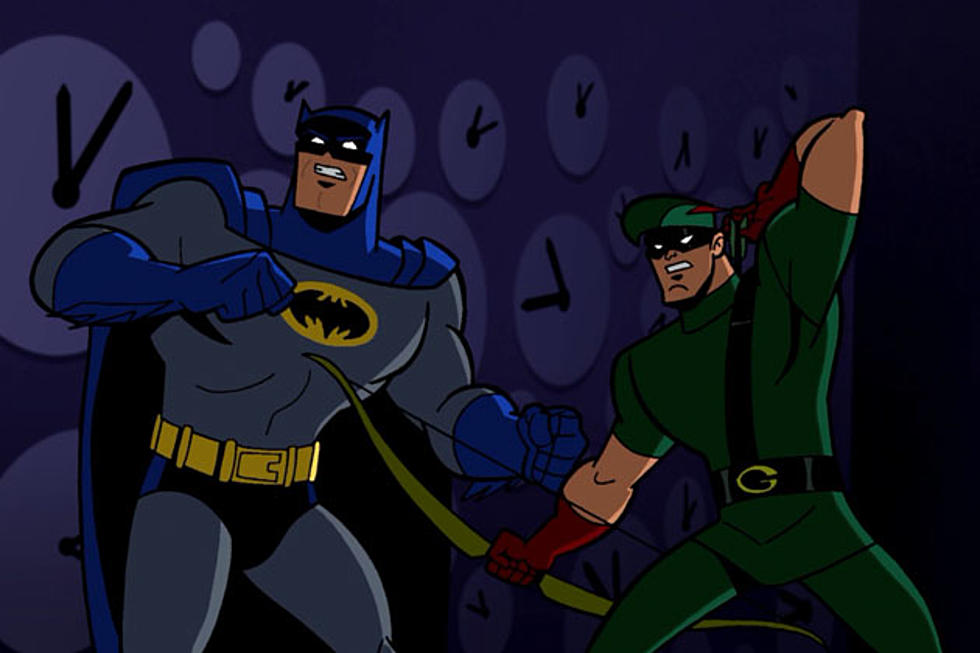![Game Designer Adam Tierney Talks ‘Batman: The Brave and the Bold The Videogame’ [Interview]](http://townsquare.media/site/622/files/2010/08/bandbgrapple.jpg?w=980&q=75)
Game Designer Adam Tierney Talks ‘Batman: The Brave and the Bold The Videogame’ [Interview]
When it comes to animated series especially suited for beat 'em up video games, Cartoon Network's "Batman: The Brave and the Bold" is not only a no-brainer, it's such a must that when WayForward Technologies announced its adaptation, fans expected the very best. The developer has consistently delivered trailers that show off fluid 2D animation, a voice cast culled straight from the show and interconnected console features on the way to the game's September 7 release.
ComicsAlliance took the opportunity to pick the brain of "Batman: The Brave and the Bold The Videogame" Designer/Director Adam Tierney to learn more aout WayForward's character selection process, the comics that influenced the title and where the game's plot fits in with the show's three seasons.

Adam Tierney: Narrowing it down was definitely a challenge! When we started on Batman: The Brave and the Bold the Videogame, the cartoon was still airing its first season, but Warner Bros. Animation gave us a detailed lineup of who would be appearing in seasons 2 and 3, so we knew which characters would be available to us. Selecting the characters was a balance of who both WayForward and Warner Bros. Interactive Entertainment wanted in the game, and also which characters fans would expect in addition to some surprises thrown in for a well-rounded mix. I'm personally a huge fan of Geoff Johns' run on The Flash, so we brought The Rogues in (Captain Cold, Heatwave, and Weather Wizard) for a teaser battle. I've also been a fan of Peter Tomasi's run on Green Lantern Corps, which is one of the reasons our playable Green Lantern is Guy Gardner (sorry, Hal fans - although he does appear as a jump- in).
As for which characters would be playable, jump-in, or supporting, the biggest deciding factor was story. The game has a huge story component (over 400 pages of running dialogue), so we teamed Batman up with characters that played well off his stick-in-the- mud attitude. Once we had our plots and primary heroes worked out, the secondary heroes were selected based on who had the coolest attacks, and the most memorable personalities. Each of their appearances is only a few seconds long, but they give you an instant impression of who that character is, such as when Booster Gold poses for Paparazzi snapshots, while letting Skeets fly around doing all the tough work.

CA: Which heroes' powers were the biggest challenge to bring to life in the game?
AT: The game was animated in 2D, identical to the art style of the TV show. So the easiest powers to produce were ones that could be visualized entirely through animation (like Batman swinging his laser sword - yeah, that's in there). The tougher ones were powers that were very organic, like Guy's ring constructs, because they needed to be usable anywhere onscreen at any angle. Abilities like that were a bit trickier to nail, but in the end the team did a fantastic job at bringing each of these iconic abilities to life.

CA: Heroes are only as good as their villains. How did you narrow down which foes the 'Brave and the Bold' roster would square off against?
AT: Like the hero selection, it mostly came down to the plots. The show is charming in the way that it pairs villains and heroes you wouldn't normally see battling, so we tried to follow suit. Of the game's four episodes, the first is the most traditionally 'Batman' to ease the player in. It takes place in Gotham City, your partner is Robin, and the primary villains are Catman and Catwoman. And just as it's important to have good banter between the two heroes, we selected villains that played off each other well, too.

CA: While "Batman: The Brave and the Bold" is generally targeted to an audience of younger boys, did you consider making any female heroes playable or drop-in allies? (If there are any female heroes featured, what made them a good fit for the game?)
AT: We did take female superheroes into consideration when making Batman: The Brave and the Bold the Videogame. Black Canary is featured as a jump-in hero, and other prominent female roles in the game include Catwoman and Arisia. Arisia also makes her speaking role debut in the game. As for why they fit well, Black Canary's got an awesome (and very visual) special ability, which makes her perfect for a jump-in hero. Catwoman worked well for our Gotham plot. And Arisia is a character I absolutely loved from the Green Lantern Corps comics, so I was excited to bring her into our Outer Space episode.

CA: The game's interconnectivity between its Wii and DS versions is a pretty rad feature. What made Bat-Mite the right character for the job?
AT: Bat-Mite's the only one aware that he's in a cartoon in the original TV show, so it made sense to feature him in some of the wackier modes of our game, where he's very aware that he's in a videogame. If players have a copy of both the Wii and DS version of the game, they can connect the two wirelessly and bring Bat-Mite into the Wii game as a third playable character, controlled on the Nintendo DS. Bat-Mite flies around, cracking jokes, and dropping health items, bombs, or anvils. It's entirely up to the player whether to help the heroes, or annoy them (which is very true to Bat-Mite's roots). This type of mode wouldn't have worked with anyone but him due to not just his abilities, but his mischievous personality, too.

CA: Can you give some insight into where the game's story fits within the narrative of the show? Is this a "Season 3" universe or more of a "Season 2" universe?
AT: That's a great question. We finished writing the game's scripts between the airing of seasons 1 and 2, however we knew the plots of season 2 and 3's episodes before then. One of our episodes is a direct sequel to an episode from season 1. The other three episodes would probably slot best into season 3, since we're using characters that debuted throughout the first and second seasons.

CA: We know that Batman's gadgets are an integral part of the game. Will other playable characters have access to weapon and item upgrades? How will that process work for someone like Blue Beetle or one of the Green Lanterns?
AT: Since Batman is controllable throughout the entire game, he's got the most gadgets His four partners have multiple gadgets each and every gadget in the game can be upgraded twice. Upgrades don't just beef up the strength of the gadget, but change how it functions. So Robin's metal staff begins to send out gusts of wind, making it more of a projectile weapon once powered up.
One of my favorite features is that Guy Gardner's gadgets are all ring-powered (naturally). So in addition to his gadget energy rejuvenating over time like everyone else, he can also take out his lantern at any moment, recite the oath, and give himself an instant boost.

CA: When it comes to beat-'em-ups, a lot of fans have mixed feelings about the Wiimote and the DS stylus. What kind of controller options will "The Brave and the Bold" players have on the Wii and the DS, and how did you approach optimizing gameplay with those unique controller options?
AT: In this game we take advantage of motion and IR only where it seemed fun, and didn't affect the core combat. All basic fighting is performed with the analog stick and buttons. Special gadget aiming is used with the Wii Remote's pointer; however we also have a non- IR component to each gadget as well. So with the Batarang, for example, you can hold down the button, and then use the Wii Remote to tag multiple enemies, and release to ping-pong your Batarang between them. Or you can simply tap the button, without aiming, to toss a few Batarangs straight forward.
Motion and IR aiming are also supported at the menus, and to charge up the jump-in attacks. So the game does take advantage of these unique Wii features, but not in any way that might lessen the precision or the player's enjoyment of the classic brawling combat.
More From ComicsAlliance







![First Impressions: ‘Adventure Time: Hey Ice King! Why’d You Steal Our Garbage?!!’ [NYCC 2012]](http://townsquare.media/site/622/files/2012/10/atgame01.jpg?w=980&q=75)

